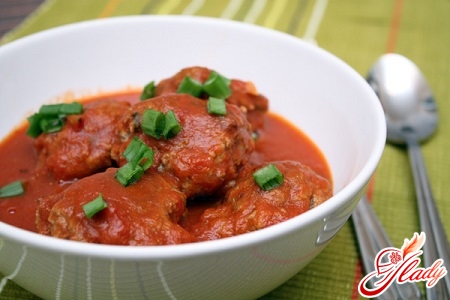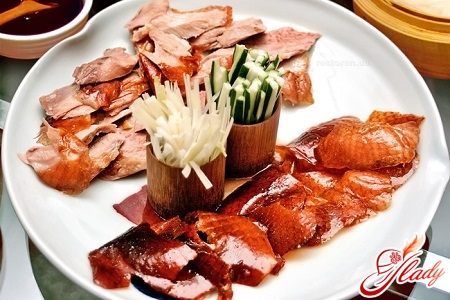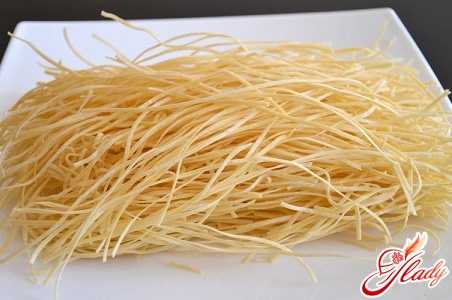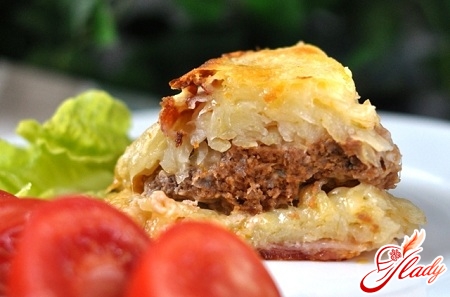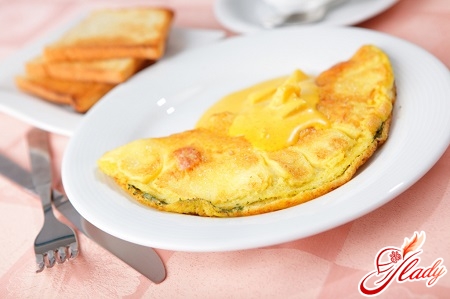
In the home kitchen can not do without such a masterpiececooking, like a normal omelet. There is an opinion that at first the omelet appeared in France. Then the preparation recipe spread all over the world. Currently, there are recipes for omelets in a provincial cafe, and in a fashionable restaurant. And in the life of bachelors the value of this product is not overestimated! The dish is delicious, satisfying and very useful, because in 100 grams of eggs contains 12.7 grams of protein, 11.5 - fats, 0.7 - carbohydrates, 0.8 grams of trace elements (potassium, calcium, phosphorus, iron, sulfur, fluorine ), vitamins, other biologically active substances. In addition, this product is unrivaled in terms of simplicity and speed of cooking, it is relatively cheap, suitable for students and pensioners alike. However, it should be remembered that everything is good in moderation. Eggs are not recommended for eating in diseases of the liver and biliary tract. Healthy people are advised to eat no more than 2 eggs a day, the elderly can afford the same amount per week. In addition, we must remember that chicken eggs are sometimes infected with a pathogen of salmonella. Therefore, they must be thoroughly washed and not drunk raw. And, of course, the eggs should be fresh. The suitability of eggs for food is checked as follows: in a half-liter jar pour water, dissolve in it a tablespoon of salt and lower the egg. If it sinks to the bottom, it means, fresh, if it floats somewhere in the middle, an egg of medium freshness. If the egg pops up, this product should not be eaten. Large poultry farms of well-known brands put the production date on the shell. Dietary (fresh) eggs are eaten for a week, canteens - 25 days. Keep in the refrigerator is allowed for not more than a month. In addition, eggs are divided into:
- the highest category (labeled "CB" in the marking) - not less than 75 g;
- selective ("CO") - 65-74.9 g;
- 1 category ("C1") - 55-64.9 g;
- 2 categories ("C2") - 45-54.9 g;
- 3 categories ("С3") - not less than 35 g.

Recipe for cooking without flour - French omelet
There are a lot of recipes for making omelets. The general rule: the best he can in a frying pan with a thick bottom. Ideally, for omelets use a separate pan. And if you do not bother, then any one will do: with non-stick coating, and without. It is rubbed with bacon and well heated. Further preparation is somewhat different for different authors. The usual scrambled eggs consist of 2 eggs (a serving of one eater), whipped with a fork or a whisk in some deep utensils, add a tablespoon of milk (water, sour cream or kefir will suit), salt to taste. Salt is added during the whipping, and not during cooking. You can whip and mixer. In this case, the taste will be slightly different. Two tea or half a tablespoon of butter are put in a frying pan. Drown it on a moderate fire, watch while not burning. Then pour the beaten eggs. Evenly distribute the omelette in a frying pan. It is very important to check after a few seconds if it has come. To do this, you need to shake the pan, but carefully, so as not to drop the omelet on the floor. If it sticks, then carefully separate it from the walls and bottom of the frying pan with a knife or a flat spatula. Fry an omelet until cooked (5-7 minutes). Classic recipes recommend that the egg mass from above is viscous (but not liquid), and from the bottom it should brown. This recipe recommends preparing an omelette quickly so that it does not cool down. And you should eat it slowly, enjoying a great taste. 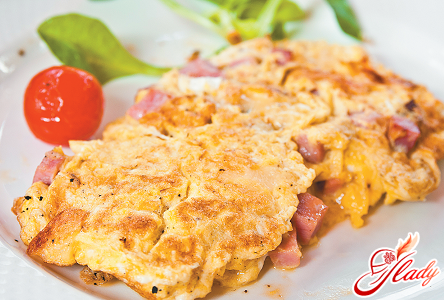
Recipe for cooking with flour - a normal omelet
There is a recipe for omelet with addedflour. In this case, take 2 eggs, add 4 tablespoons of milk, 1 tablespoon (without a slide) of flour, salt, 20 grams of butter (one tablespoon). Omelette can be cooked both under the lid and without it. At the end of the cook, sometimes fried eggs are turned over to get a mouth-watering crust on both sides. Instead of butter, some recipes recommend taking sunflower oil. The classic recipe for an omelet is exactly this, it does not provide any more additives. But what can we prevent from filling it with vegetables, mushrooms, green peas, brains, pieces of sausage, ham, herring, anything? After all, eggs are very versatile, in compatibility with various ingredients, the product. Forcemeat smear one half of the omelet and cover the other. Some recommend sprinkling it with parsley or dill. In addition to cooking omelettes in a frying pan on an open fire (or on an electric stove), there are cooking recipes in the ovens. In this case, the pan with the omelet is placed for 8-10 minutes in the oven, heated to 180-200 degrees. There is an opinion that scrambled eggs and scrambled eggs are different dishes. Yes, in eggs, eggs are not beaten, but scrambled eggs are practically nothing from omelets. In the countries of the former USSR, eggs are scrambled with the addition of milk (other dairy products or water), flour and salt. But the French do not add anything to the omelette. All the excellent mood, health and bon appetit!




